Did you know that you can grow a wide number of fruit Bonsai trees? When grown in miniature, the average fruiting Bonsai tree doesn’t necessarily produce fruit in large quantities or at full size. However, keeping a Bonsai tree is a rewarding, visual marvel, especially if you choose to grow a common fruit tree in a small container!
Whether you are brand new to Bonsai trees or already have a working knowledge of their care, just about any tree species or shrub can be grown in miniature. Wondering which fruit trees make great Bonsai tree specimens? From the most common to the rare, here is a list of potential fruit tree species that make amazing Bonsai trees.
Guidelines for Fruit Bonsai Trees
No matter what type of fruit tree you choose to grow in miniature, there’s a lot to know about Bonsai tree care. With practice and patience, you can grow just about any type of shrub or tree as a Bonsai tree. However, getting it to produce fruit, edible or otherwise, can be tricky. With a rigorous watering and fertilizing schedule, as well as proper Bonsai tree placement, you may be surprised at what your Bonsai tree can do!
Keep in mind that all Bonsai tree cultivation takes time, especially fruit trees. You likely won’t see fruit growth in your fruit Bonsai tree right away, or even after multiple years. Bonsai tree cultivation is all about maintenance, precise shaping, and patience. It will likely feel tedious, but that’s all part of the mindful experience of Bonsai tree ownership!
With all of this in mind, here are some fruit trees that can be grown using Bonsai tree cultivation methods.
Apple

While it takes a long time for the fruit to mature, you can eat apples from your apple Bonsai tree!
©Raquel Pedrosa/Shutterstock.com
Seeing the distinct shape of an apple growing on a miniature tree is quite a sight. Members of the Malus plant genus, apple trees can be crafted into Bonsai trees with care. However, many Bonsai tree artists choose to create crabapple Bonsai trees rather than apple Bonsai trees. This is largely due to the size of the fruits produced by crabapples versus apples. However, this isn’t to say that you can’t grow a standard apple tree in miniature. Just expect the fruits to be a bit oversized for your tree!
Crabapple
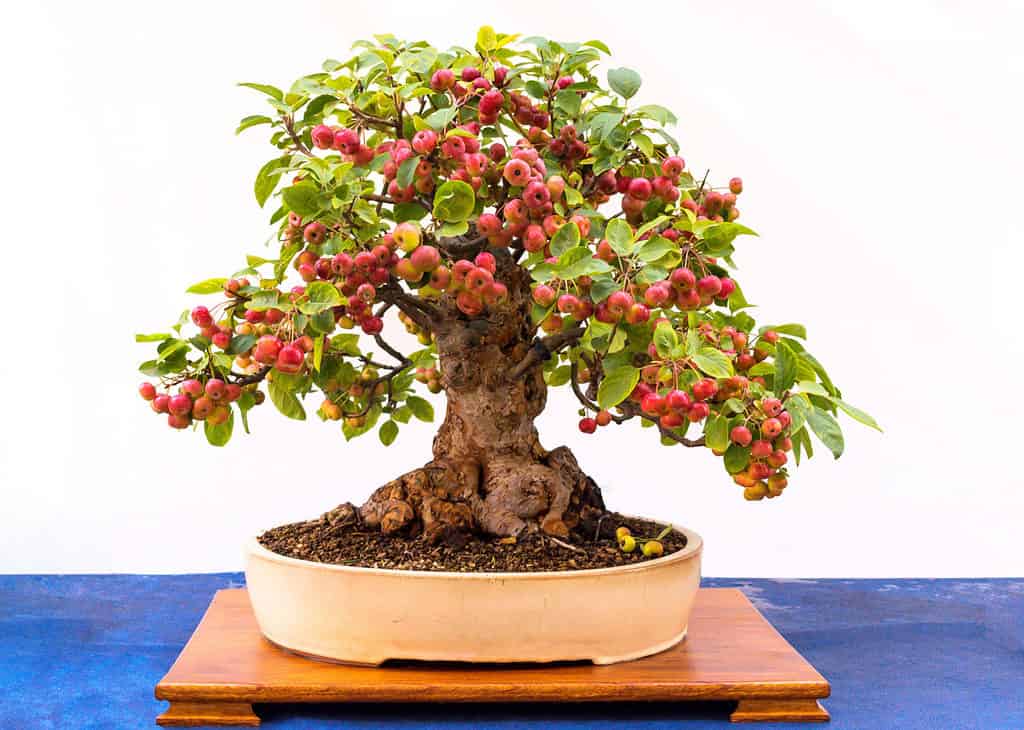
It’s easier to grow a crabapple Bonsai tree rather than an apple Bonsai tree.
©Sergio Arjona/Shutterstock.com
Likely the most popular fruiting Bonsai tree, crabapple trees are easy to repot and care for. If you are beginning your Bonsai tree journey and are seeking a fruit tree for miniature cultivation, crabapple Bonsai trees will likely yield the best results. If kept outdoors, the preferred location for crabapple Bonsai trees, bees and other pollinators will help with fruit production in the springtime, after blossoms have formed.
Pomegranate
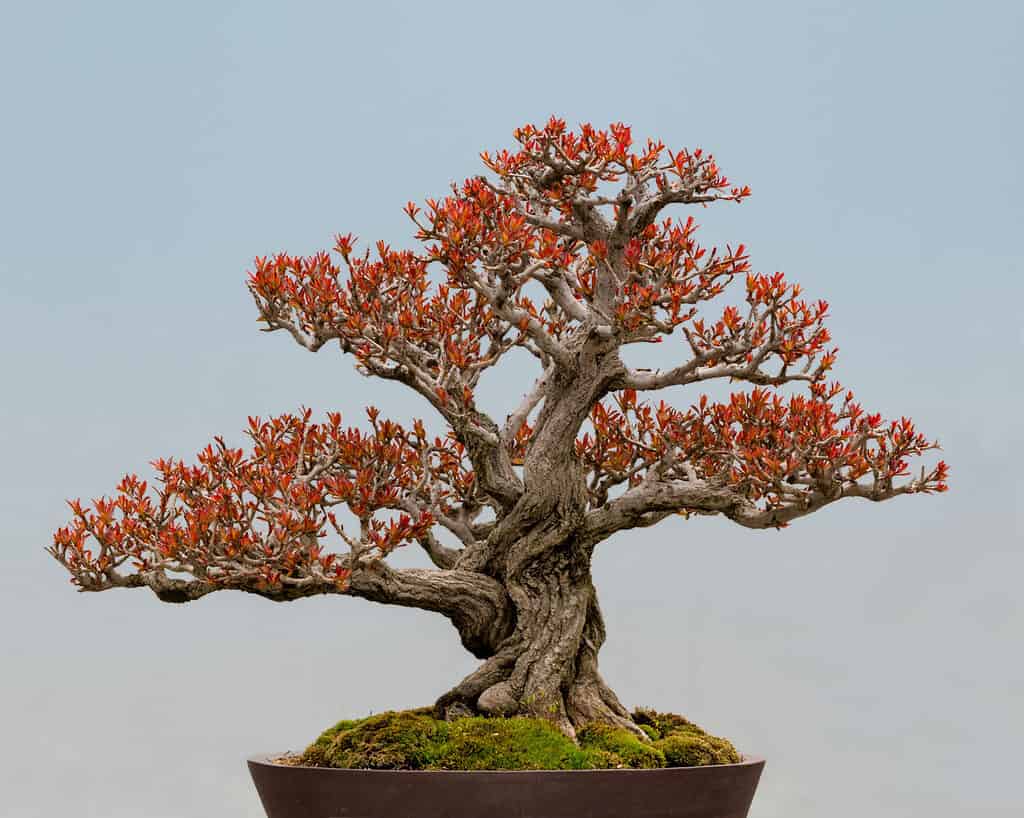
Your pomegranate Bonsai may produce tiny fruit!
©Nagel Photography/Shutterstock.com
With intricate branches and a naturally twisting growth habit, pomegranate trees are fairly popular in Bonsai tree cultivation. Depending on the species, your pomegranate tree likely won’t produce large fruits when grown in miniature. However, these Bonsai trees are beautiful to look at, no matter the season. And it will still produce miniature pomegranates, so long as your specimen is healthy and properly cared for!
Cherry
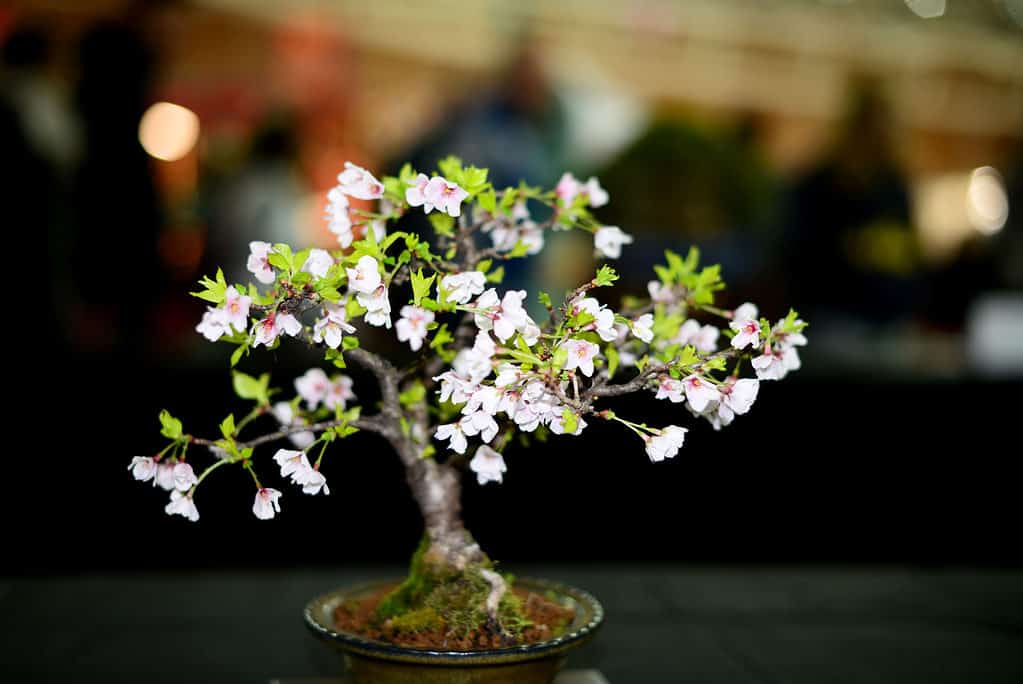
Popular for its blooms, cherry Bonsai trees are beautiful.
©PhotoMik/Shutterstock.com
There’s nothing like a Bonsai tree covered in cherry blossoms. These delicate pink blooms reflect Japanese culture as much as any Bonsai tree, so choosing to cultivate any type of cherry tree in this way feels like a proper homage (even though Bonsai trees originated in China!). Most ornamental cherry trees are great choices for Bonsai tree cultivation. The bark of most cherry varieties grows more gnarled and intricate with age.
Lemon
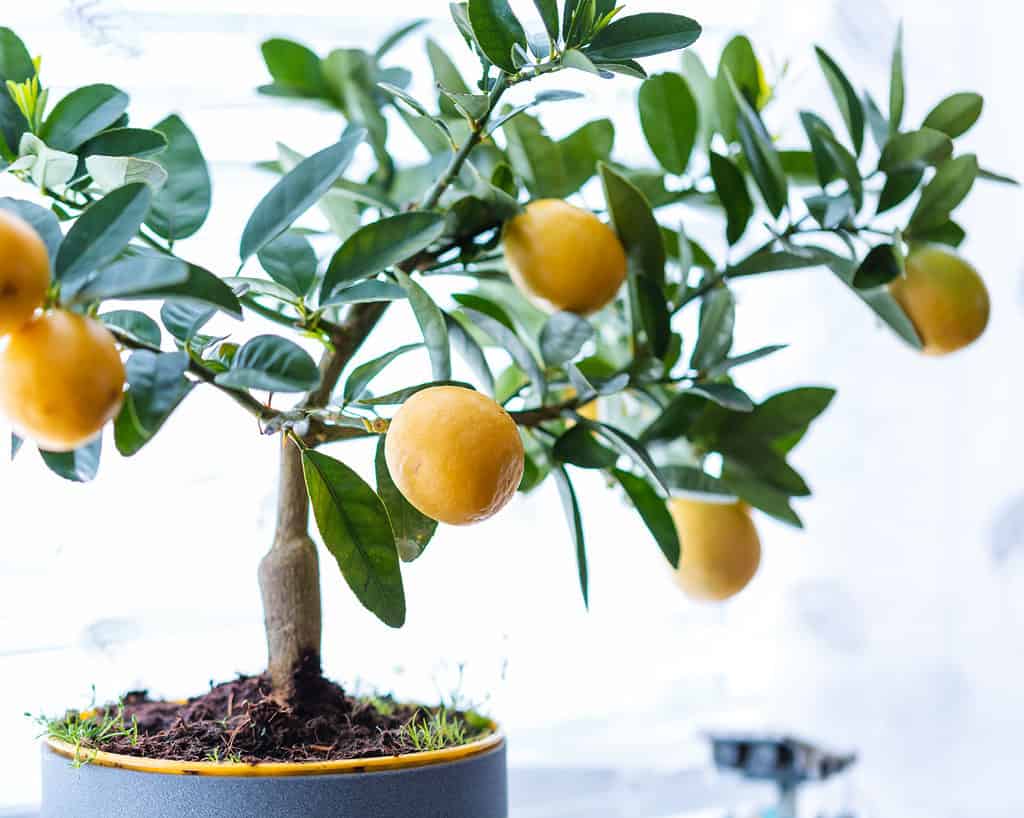
Not all types of lemon trees do well when grown in a miniature Bonsai tree format.
©Aidask/Shutterstock.com
There are a number of different miniature lemon tree species that work well for Bonsai tree cultivation. However, keep in mind that you will need to live in a location that supports citrus growth and cultivation. This likely means that you need temperate climates with warm summers, and your lemon tree will prefer full sunlight. Depending on the health of the tree and the species that you choose, you may not get full size lemons on your lemon Bonsai tree, but the petite options are certainly conversation starters!
Japonica
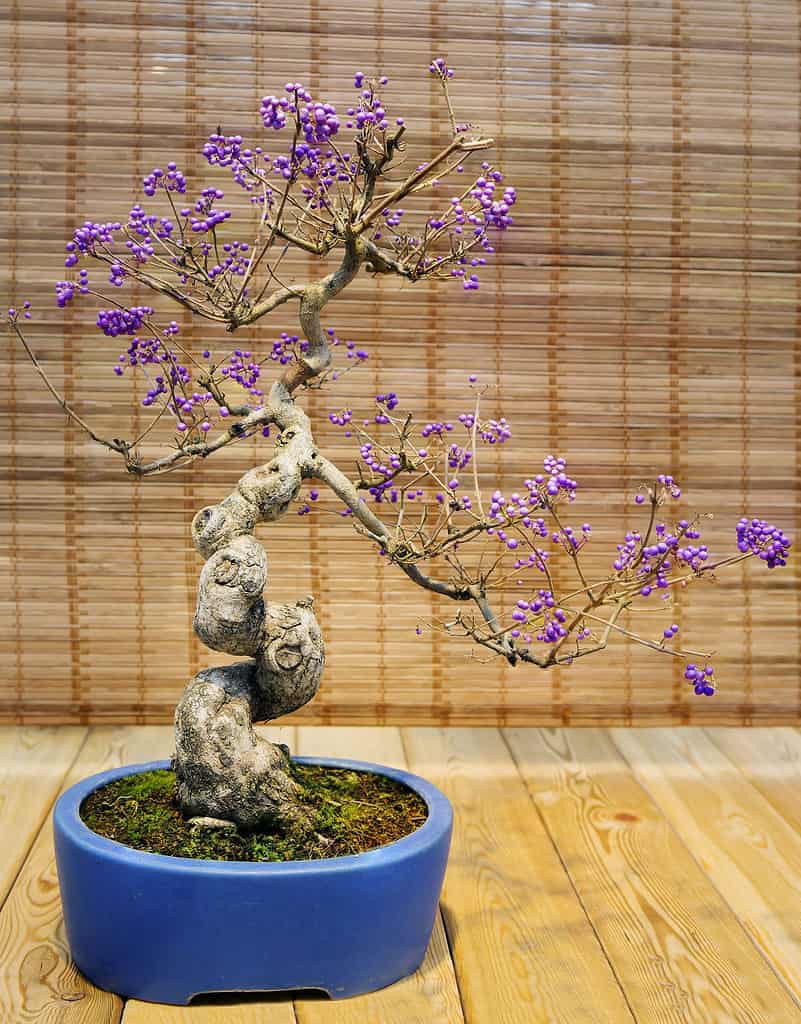
Some japonica Bonsai trees produce unique purplish fruits.
©Galina Savina/Shutterstock.com
Scientifically classified as Callicarpa japonica, this Bonsai tree specimen is unique. It produces small, purplish berries that aren’t technically edible for human consumption. However, the leaves can be used to make tea and the berries on this Bonsai tree specimen makes it gorgeous enough to enjoy, no matter how edible! The Callicarpa japonica is a popular shrub species in Japan and should be fairly easy to care for in the right environment.
Persimmon

One of the most popular fruiting Bonsai trees is the persimmon.
©ilovehz/Shutterstock.com
If you have yet to eat a persimmon in your life, now’s the time. Members of the Diospyros genus, there are a number of persimmon fruit trees that make excellent Bonsai tree specimens. The American persimmon is one such example, often producing fruits that are a similar size when grown in miniature. Keep in mind that persimmon trees don’t typically produce very many branches, likely limiting your overall design. However, persimmon tree deadwood is beautiful and makes a delightful contrast to the bright yellow and orange fruits found in its boughs!
Orange

Only some species of orange trees are suited for Bonsai tree cultivation.
©lucas nightingale/Shutterstock.com
Just like a lemon Bonsai tree, orange Bonsai trees need plenty of light and an ideal climate in order to thrive. There are also miniature orange tree species and it is likely best to begin with one of these specimens if you want to shape your orange tree into a Bonsai tree landscape. Fertilizer and other care requirements for citrus will need to be followed carefully so that your miniature orange tree produces plenty of oranges!
Red Currant
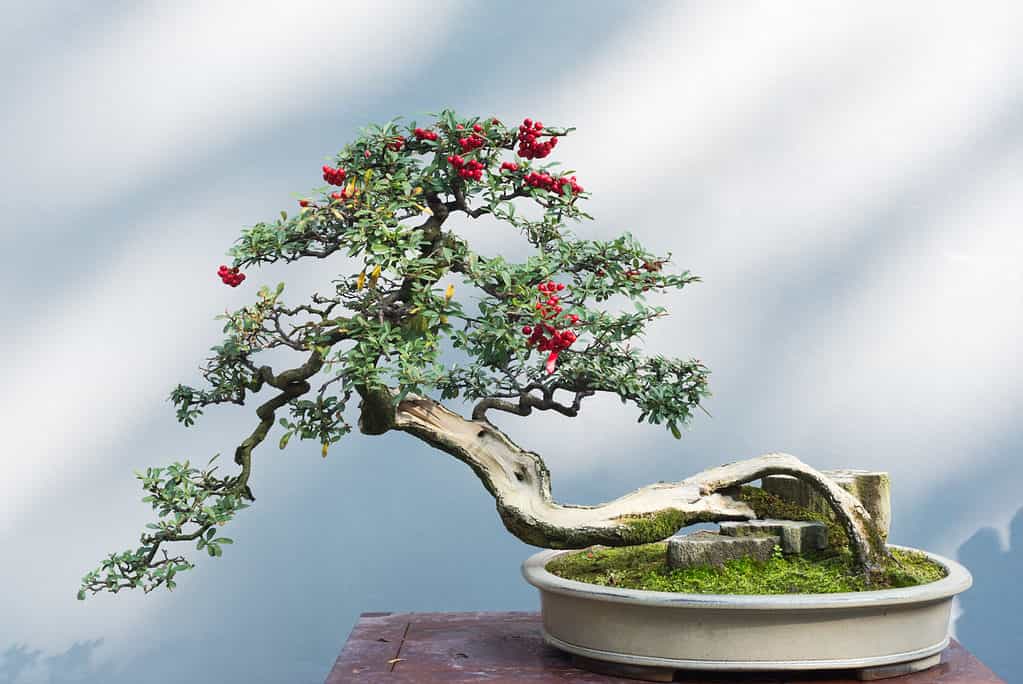
With shiny, small fruits, the red currant Bonsai tree makes a statement.
©LP2 Studio/Shutterstock.com
With small, bright red berries, red currant trees make great Bonsai tree specimens. While they have a distinctly upright growth habit, red currant trees are fairly easy to shape into a number of different Bonsai tree styles and designs. Keep in mind that the red currant tree was once banned in a number of states to try and minimize certain diseases and fungal infections among other tree species. Make sure that your location allows for the growth of a red currant tree before you fall in love.
Quince

Most quince Bonsai trees produce larger fruits than the tree can support.
©khuntapol/Shutterstock.com
There are a number of difference quince species, making it a popular choice for both a flowering and fruiting Bonsai tree. Depending on the species that you choose, quince plants produce flowers in a number of colors. Chances are, your quince Bonsai tree will produce fruits that are fairly large for the size of the tree, but they will be edible and delicious! The European quince and the Chinese quince are some of the most popular species used for Bonsai tree cultivation, though these trees will likely need to be larger than the average miniature Bonsai scene.
Star Fruit
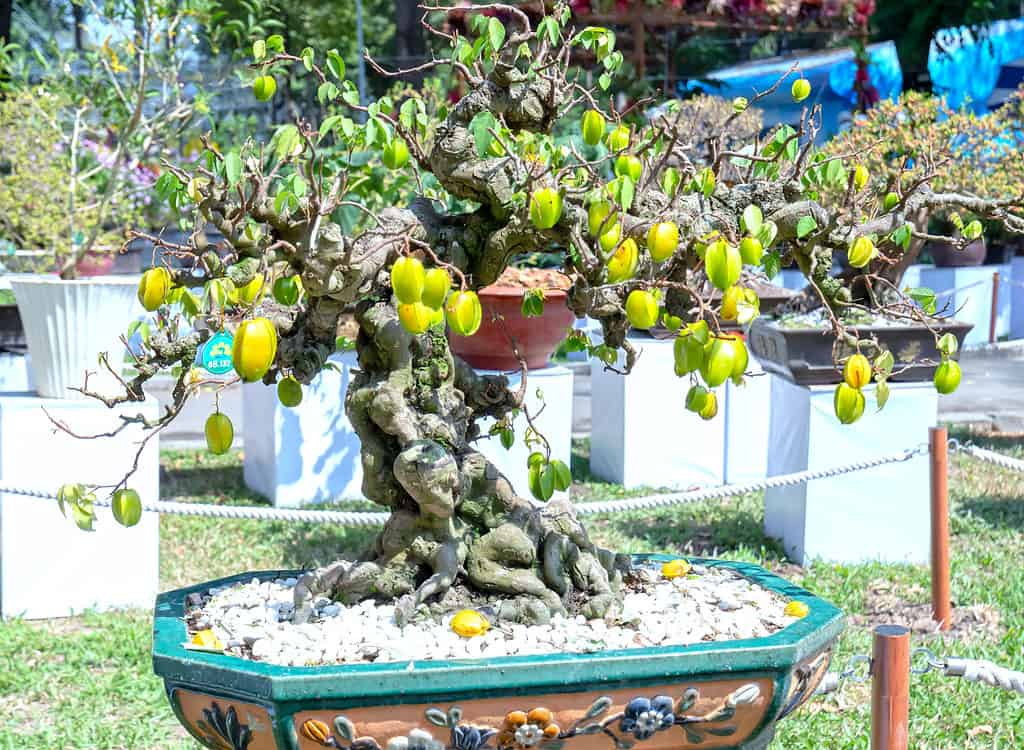
With intricate bark and gorgeous fruit, a star fruit Bonsai tree is worth mastering.
©Huy Thoai/Shutterstock.com
If you want a fruit Bonsai tree that really makes a statement, you should consider cultivating a star fruit Bonsai tree. Not only are the fruits of this particular tree yellow and uniquely shaped, but the bark and branches of most star fruit trees are intricate and highly detailed. While it can be tricky to grow in a way that produces fruit regularly, star fruit is delicious and a joy to work with!
Blueberry
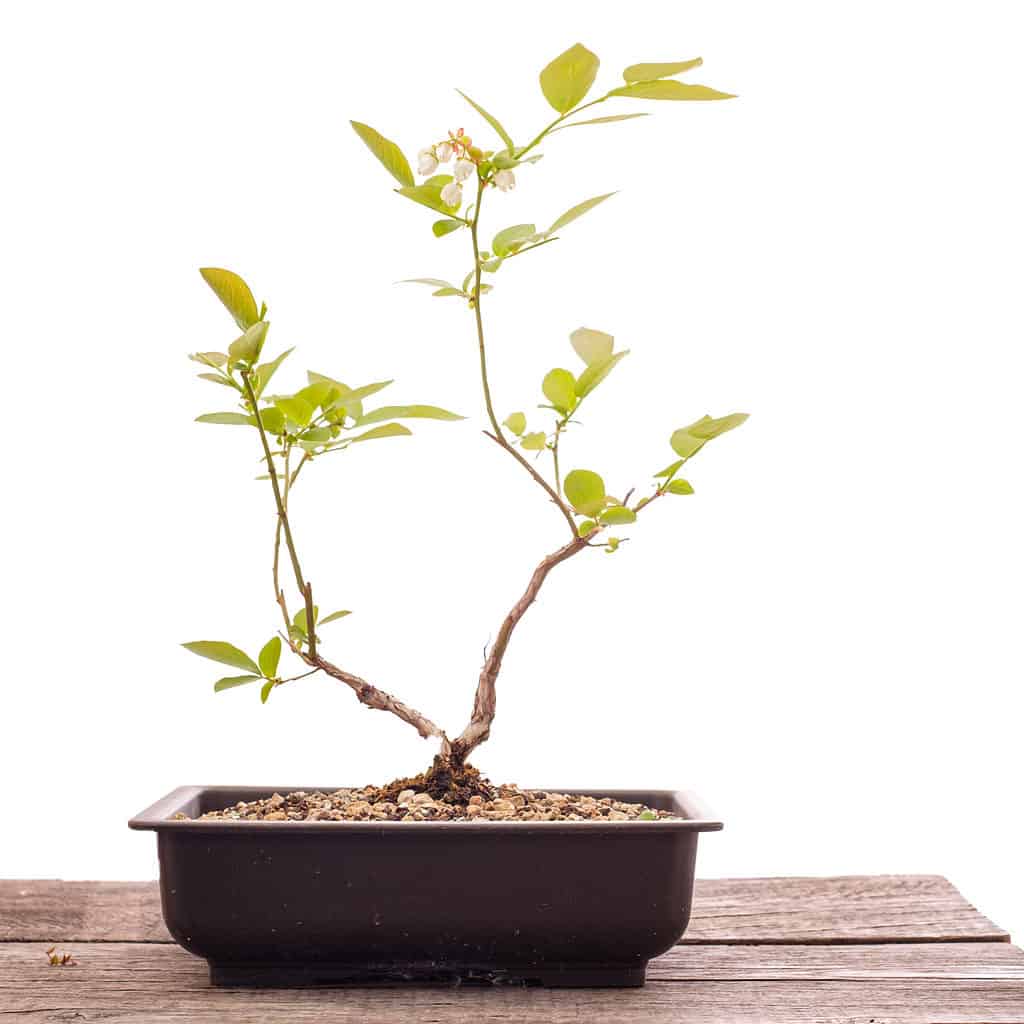
Even the average blueberry shrub can be cultivated as a Bonsai tree!
©Bernd Schmidt/Shutterstock.com
Any standard blueberry shrub can be grown as a blueberry Bonsai tree. Plus, blueberries are typically small enough that they pair well in a miniature format. Thriving in full sunlight outdoors, blueberry Bonsai trees likely won’t produce edible fruits until their third, fourth, or fifth year of growth. However, this is a relatively hardy Bonsai tree specimen to cultivate, taking well to pruning and a variety of temperature conditions.
Plum

You may enjoy the bark of a plum Bonsai tree enough to forget it even produces fruit!
©LP2 Studio/Shutterstock.com
Often grown for its flowers and foliage alone, plum Bonsai trees are delicate and beautiful. The Chinese sweet plum is a commonly cultivated indoor Bonsai tree specimen, beloved for its foliage and small fruits. Learning how to water a plum Bonsai tree takes some practice, but this is one of the few fruit Bonsai trees that is designed to be grown indoors, depending on the species. Plus, its fairly flexible wood makes it easy to shape.
Apricot

While rare, apricot trees make beautiful Bonsai tree specimens.
©hoanglong/Shutterstock.com
With knotted wood and the ability to create edible fruits in the fall, apricot Bonsai trees are fairly rare in the Bonsai tree cultivation community. However, they are a joy to witness as the seasons change, producing extremely fragrant flowers in the springtime. You may be able to cultivate your apricot Bonsai tree indoors, depending on the species. However, most enjoy outdoor weather conditions and the ability to change with the seasons.
Olive
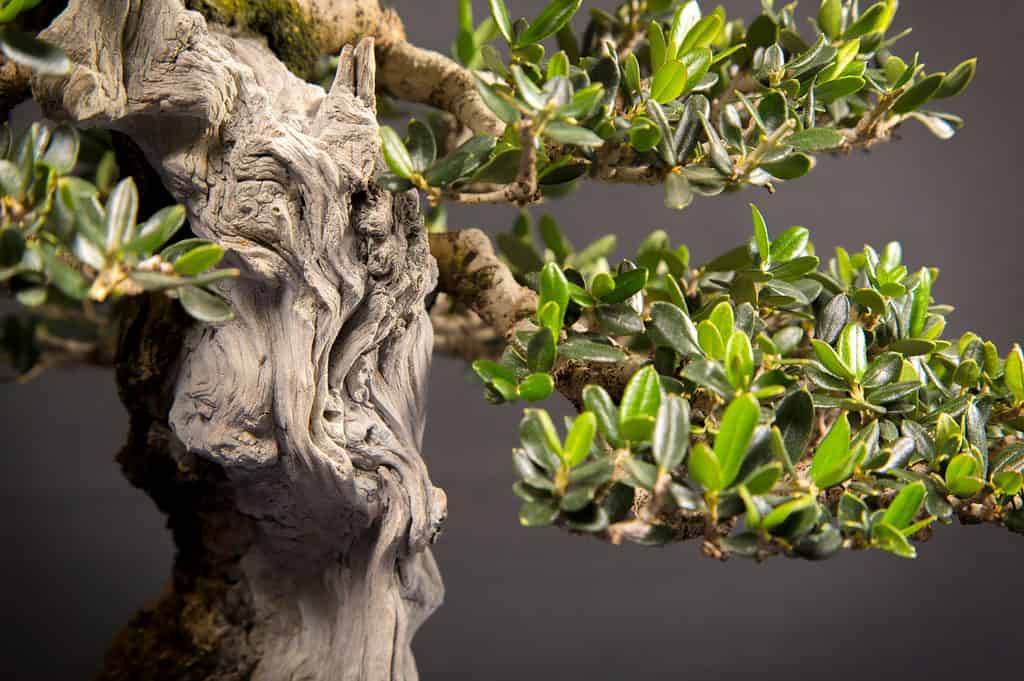
Your olive Bonsai tree may need protection in the winter.
©Luis Rojas Estudio/Shutterstock.com
If you didn’t know already that olives are technically fruit, you know now! One of the more popular Bonsai trees specimens for beginners, olive trees only get better with age. In a properly cared for tree, it should produce olives that are indeed edible, if not a bit smaller than average. The small leaves and deadwood found in the average olive tree species makes it gorgeous, whether or not it produces fruit.
Fig
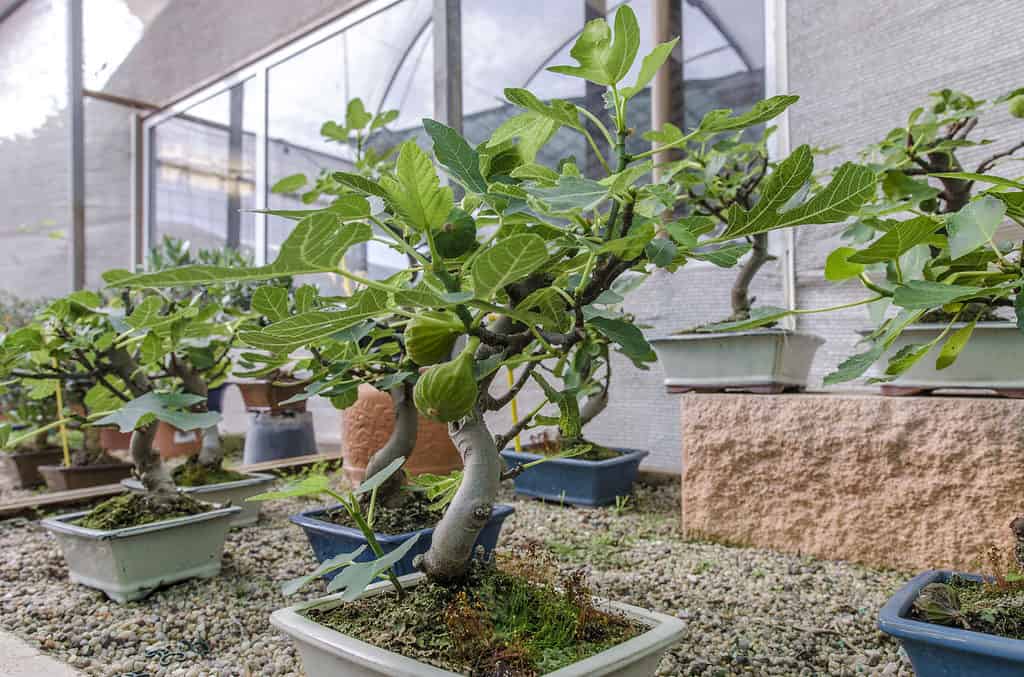
If grown in the proper climate, you may get edible figs on your ficus Bonsai tree.
©sunlight19/Shutterstock.com
While difficult to achieve, your ficus or fig Bonsai tree can produce edible figs. While the ficus species is one of the most commonly cultivated Bonsai tree species around, particularly for beginners, it can be tricky getting them to flower and fruit. If you know that your fig Bonsai tree is a species that produces edible fruit, you’ll need to maintain a high level of humidity and a detailed fertilizing routine. This Bonsai tree needs to be grown indoors, but you are more likely to get fruit from this species if you live in a climate where it can grow outside in hot and humid temperatures.
Summary of the 16 Best Fruit Bonsai Trees
Here is a list of the 16 best fruit bonsai trees:
| Rank | Tree | Fruit |
|---|---|---|
| 1 | Apple | Oversized fruit |
| 2 | Crabapple | Miniature fruit |
| 3 | Pomegranate | Miniature fruit |
| 4 | Cherry | Flowers |
| 5 | Lemon | Miniature to full size fruit |
| 6 | Japonica | Inedible berries; leaves can be used to make tea |
| 7 | Persimmon | Miniature fruit |
| 8 | Orange | Miniature fruit |
| 9 | Red Currant | Fruit |
| 10 | Quince | Oversized fruit |
| 11 | Star Fruit | Miniature fruit |
| 12 | Blueberry | Edible fruits after 3rd, 4th, or 5th year of growth |
| 13 | Plum | Miniature fruit |
| 14 | Apricot | Miniature fruit |
| 15 | Olive | Smaller than average fruit |
| 16 | Fig | Miniature fruit |
Honorable Mention: Other Best Bonsai Trees
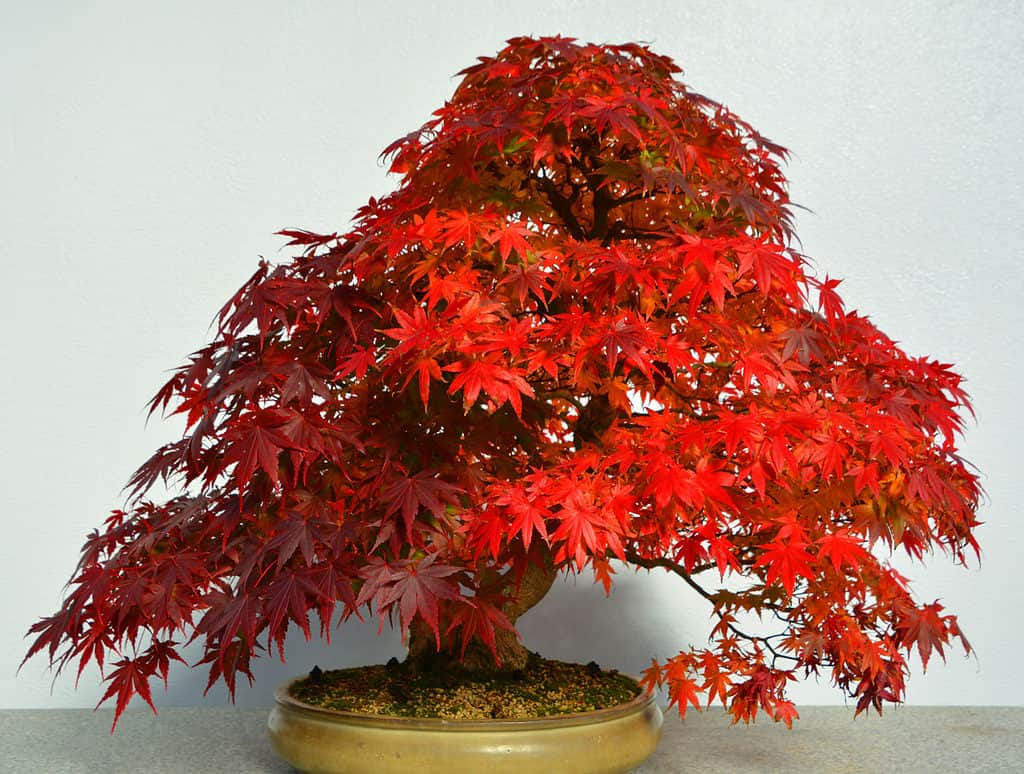
Changing colors in the fall, Japanese maple Bonsai trees always display beautiful foliage.
©meunierd/Shutterstock.com
It is said that any tree varietal can be made into a bonsai tree. Additionally, any plant with a permanent wood-like structure, including a cactus or a shrub, can also be turned into this tiny tree. With so many options, knowing which one to choose, or even make your own, can seem daunting. If you dream of adding a mini fruit garden to your yard, or want a beautiful tree to add to your collection, and want to find more of a selection than the 16 best mentioned above, here is an additional collection of tiny treasures that each deserves to be mentioned.
- Ginseng Ficus (Ficus Retusa) – one of the best bonsai trees for beginners due to its resilience and forgiving nature. It is extremely low-maintenance and is an indoor tree. Often referred to as a banyan-style tree due to its complex root system, they enjoy occasional misting and warmer temperatures.
- Japanese Winterberry (Ilex serrata) – also known as the Japanese deciduous holly bonsai, this bonsai does well both indoors and outdoors, but will need to be protected from frost as it doesn’t do well in cold. They don’t grow as fast as others, like the Ficus, and need full sun.
- Japanese Maple (Acer Palmatum) – this deciduous tree is one of the most beautiful bonsais and its leaves will also change with the seasons. They aren’t as easy as other trees to maintain and tend to require plenty of attention, they need a good deal of water, and don’t do well indoors, but if kept properly, they will provide you with a beautiful garden addition.
- Japanese Flowering Cherry (Prunus Serrulata) – believed to signify friendship, these ornamental, deciduous trees are said to be one of the best bonsais for your home because they are easy to train due to their branches and trunks being easily pliable and better to shape.
The photo featured at the top of this post is © Sergio Arjona/Shutterstock.com
Thank you for reading! Have some feedback for us? Contact the AZ Animals editorial team.






